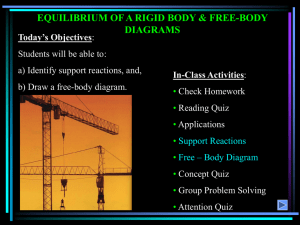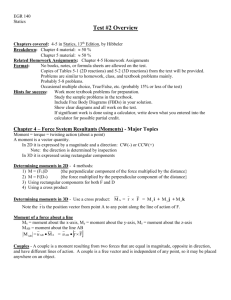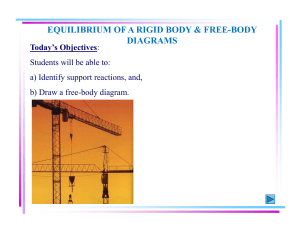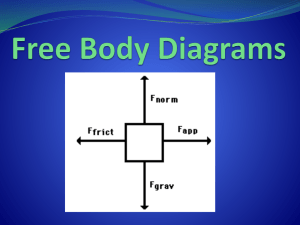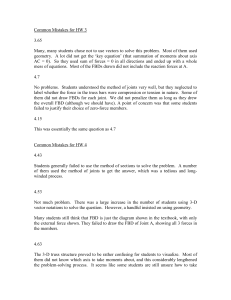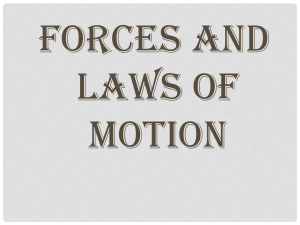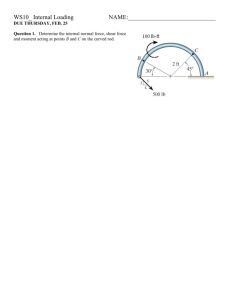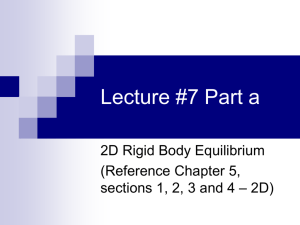EQUILIBRIUM OF A RIGID BODY & FREE
advertisement
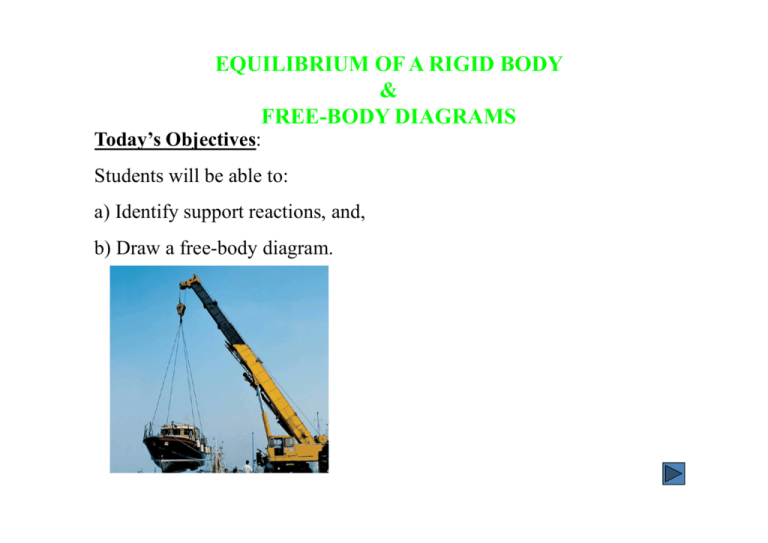
EQUILIBRIUM OF A RIGID BODY & FREE-BODY DIAGRAMS Today’s Objectives: Students will be able to: a) Identify support reactions, and, b) Draw a free-body diagram. READING QUIZ 1. If a support prevents translation of a body, then the support exerts a ___________ on the body. A) Couple moment B) Force C) Both A and B. D) None of the above 2. Internal forces are _________ shown on the free body diagram of a whole body. A) Always B) Often C) Rarely D) Never APPLICATIONS The truck ramp has a weight of 400 lb. The ramp is pinned to the body of the truck and held in the position by the cable. How can we determine the cable tension and support reactions ? How are the idealized model and the free body diagram used to do this? Which diagram above is the idealized model? APPLICATIONS (continued) Two smooth pipes, each having a mass of 300 kg, are supported by the tines of the tractor fork attachment. How can we determine all the reactive forces ? Again, how can we make use of an idealized model and a free body diagram to answer this question? CONDITIONS FOR RIGID-BODY EQUILIBRIUM In contrast to the forces on a particle, the forces on a rigid-body are not usually concurrent and may cause rotation of the body (due to the moments created by the forces). Forces on a particle For a rigid body to be in equilibrium, the net force as well as the net moment about any arbitrary point O must be equal to zero. ∑ F = 0 (no translation) Forces on a rigid body and ∑ MO = 0 (no rotation) THE PROCESS OF SOLVING RIGID BODY EQUILIBRIUM PROBLEMS For analyzing an actual physical system, first we need to create an idealized model (above right). Then we need to draw a free-body diagram (FBD) showing all the external (active and reactive) forces. Finally, we need to apply the equations of equilibrium to solve for any unknowns. FREE-BODY DIAGRAMS (Section 5.2) Idealized model Free-body diagram (FBD) 1. Draw an outlined shape. Imagine the body to be isolated or cut “free” from its constraints and draw its outlined shape. 2. Show all the external forces and couple moments. These typically include: a) applied loads, b) support reactions, and, c) the weight of the body. FREE-BODY DIAGRAMS (continued) Idealized model Free-body diagram 3. Label loads and dimensions on the FBD: All known forces and couple moments should be labeled with their magnitudes and directions. For the unknown forces and couple moments, use letters like Ax, Ay, MA, etc.. Indicate any necessary dimensions. SUPPORT REACTIONS IN 2-D A few example sets of diagrams s are shown above. Other support reactions are given in your textbook (Table 5-1). As a general rule, if a support prevents translation of a body in a given direction, then a force is developed on the body in the opposite direction. Similarly, if rotation is prevented, a couple moment is exerted on the body in the opposite direction. EXAMPLE Given: The operator applies a vertical force to the pedal so that the spring is stretched 1.5 in. and the force in the short link at B is 20 lb. Draw: A an idealized model and freebody diagram of the foot pedal. CONCEPT QUIZ 1. The beam and the cable (with a frictionless pulley at D) support an 80 kg load at C. In a FBD of only the beam, there are how many unknowns? A) 2 forces and 1 couple moment B) 3 forces and 1 couple moment C) 3 forces D) 4 forces CONCEPT QUIZ 2. If the directions of the force and the couple moments are both reversed, what will happen to the beam? A) B) C) D) The beam will lift from A. The beam will lift at B. The beam will be restrained. The beam will break. GROUP PROBLEM SOLVING Draw a FBD of the crane boom, which is supported by a pin at A and cable BC. The load of 1250 lb is suspended at B and the boom weighs 650 lb. GROUP PROBLEM SOLVING (continued) FBD GROUP PROBLEM SOLVING Draw a FBD of member ABC, which is supported by a smooth collar at A, roller at B, and link CD. GROUP PROBLEM SOLVING (continued) FBD ATTENTION QUIZ 1. Internal forces are not shown on a free-body diagram because the internal forces are_____. (Choose the most appropriate answer.) A) Equal to zero B) Equal and opposite and they do not affect the calculations C) Negligibly small D) Not important 2. How many unknown support reactions are there in this problem? A) 2 forces and 2 couple moments B) 1 force and 2 couple moments C) 3 forces D) 3 forces and 1 couple moment
